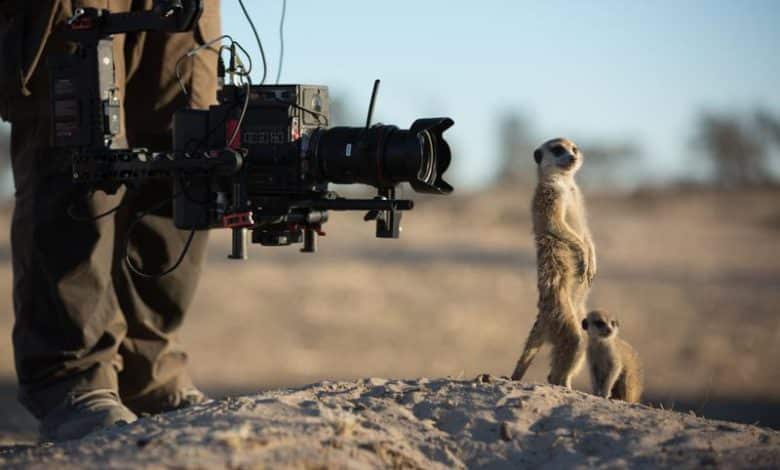Nat Geo’s ‘Hostile Planet’ Shows The True Reality of Tragedy And Triumph In The Planet’s 6 Harshest Environments

Written by: Jennifer Ortega
Cameraman Tom Walker uses a gyro-stabilized camera to film meerkats (Suricata suricatta) in the Kalahari Desert. The meerkats are being studied as part of a long-term university project and have become completely used to seeing human beings. To a meerkat habituated in this way, a human being is no more a threat than a tree or bush. Working alongside scientists, the crew was able to get intimate, close-up shots of these meerkats, despite them being completely wild. (National Geographic/Holly Harrison)
National Geographic has once again brought us a truly remarkable and groundbreaking series with ‘Hostile Planet’. The show is beyond powerful. It is gut-wrenching yet filled with these beautiful moments of adaption and triumph. ‘Hostile Planet’ effectively displays with a masterful use of cinematography just how magnificent and strange and wonderful this planet is, hopefully reminding everyone of the need to protect and celebrate Earth.

Greenland – Cameraman Barrie Britton prepares to film barnacle geese. The 400-foot basalt cliffs provided unstable filming platforms. Over thousands of years, the freeze/thaw cycle has split the rocks. Many of them are balanced delicately on top of each other so the crew had to be extremely careful whenever they were working on, or under, the cliffs. On several occasions the crew witnessed avalanches. (National Geographic/Miguel Willis)
The six-part series is executive produced by Academy Award-winning cinematographer and director Guillermo Navarro (“Pan’s Labyrinth”), Emmy-nominated producer Martha Holmes (“The Blue Planet”), Emmy Award-winning Tom Hugh-Jones (“Planet Earth II”), BAFTA winner Delbert Shoopman (“The Island”) and BAFTA winner Bear Grylls (“The Island”). Famed survivalist Grylls also hosts the series and provides narration. Each episode focuses on one of the six most extreme environments animals inhabit on this planet. From the snow leopards in the highest mountains of the world to the arctic wolves that roam the brutal & unrelenting frigid poles, each episode paints a haunting narrative of survival and adaption as the climate continues to change.

BRAZIL – Flooded Forest Filming Brazil, Camera operator Cristian Dimitrius, Capturing an immersive landscape piece on the wettest time of year in the Amazon Jungle. (National Geographic/Cristian Dimitrius)

Chicks creche, waiting for their parents to return with food at the Cape Washington Emperor Penguin colony.(National Geographic/Tanja Bayer)

(From Left to Right) Producer: Guillermo Navarro, Producer: Martha Holmes, Host: Bear Grylls, Producer: Tom Hugh-Jones, Director/Cinematographer: Mateo Wilis.
‘Hostile Planet’ traveled all seven continents leaving with 1800 hours of footage over 1300 days of shooting using the latest technology to provide access to the most remote and adverse corners of the world. Hollywood First Look Features was given a sneak peek of the series and able to participate in an eye-opening press panel featuring host Bear Grylls, director/cinematographer Mateo Wilis and producers Guillermo Navarro, Tom Hugh-Jones & Martha Holmes. ‘Hostile Planet’ is a true reinvention of the wildlife show. There will be no version of Jack Hanna bringing an owl on stage for the audience to ooh and ahh at. As Bear Grylls put it, “It is a dark canvas because it’s harsh and hard. But you can see the real moments of light against the dark and this series has remarkable beautiful moments of life.” As an expert himself on survival, Grylls is the perfect host for the show. “The lessons of my survival experiences have taught me that the reality of surviving in some of these harsh places is really tough. It takes resilience, adaptability, resourcefulness, intelligence, and community. And this is what these animals are showing in a huge amount. They are learning to work against where they don’t have the strength or speed. They are having to be resourceful and clever and communicate.”

KENYA – African bull elephant searches for a mate in Amboseli National Park. It’s been attracted by the scent of a female in estrous. (National Geographic/Tom Greenhalgh)
Part of what makes ‘Hostile Planet’ so visceral and emotional is the spectacular cinematography that is incredibly effective at grabbing on to the audience and connecting you with these animals. The series director & cinematographer Mateo Wilis spoke about the technology used and how it really impacted the overall feel of the show. “One of the kits that we used on this program for the first time was a racing drone. So when we filmed for example, in a sequence about eagles, we wanted to give the audience the experience of what it felt like to be an eagle soaring through the mountains. The way to do that is to get a racing drone that flies at 100 miles an hour and put a camera on it and then get a really good pilot to fly within a foot of a cliff to give you a real sense of movement.” Producer Guillermo Navarro added, “We wanted it to become an experience for the audience because our lenses and cameras would be able to get there. So this technology allowed us to do this as an immersive experience. It means that the audience connects with what’s happening and what the animals are going through.”

A caracal (Caracal caracal) prowls through the Namib Desert, looking for food in the cool of the afternoon. Caracals are the heaviest of Africa’s small cats, they can weigh in at over 40 pounds. Normally nocturnal to avoid the heat of the sun, they can also hunt at dusk and dawn – or even during the day if conditions are right. (National Geographic/Stephanie Thompson)

TANZANIA – 2 bull hippos fight for space in Katavi National Park. During the dry season, their pool of water shrinks and fights break out as the hippos are forced closer and closer together. (National Geographic/Tom Greenhalgh)

TANZANIA -Six hundred hippos cram into one pool of water in Katavi National Park. During the dry season, the pool of water shrinks, and more and more hippos are forced closer together. (National Geographic/Tom Greenhalgh)

A Cape cobra (Naja nivea) sunbathes in the Kalahari Desert. Meerkats enthusiastically harass cobras that stray near their burrows. The cobras, which can be over 3.3 feet long, defend themselves by striking repeatedly – which the meerkats dodge while biting at the snake’s body. Part of the meerkats’ bravado can be attributed to their impressive ability to withstand snakebites. (National Geographic/Holly Harrison)
Truly what ‘Hostile Planet’ does so remarkably well through all these harrowing narratives brings a real connection to the animals. “We want to convey just how amazing the natural world is and in the end that is what will make people want to protect it.” If you are looking for some light entertainment this is not it. This is more like Martin Scorsese’s ‘Mean Streets’ meets The Himalayas. The reality for the animals that roam these diverse environments is harsh and extremely heartbreaking and tragic to watch at times, but this is what makes the show so important. By coming face to face with the struggles for these species, you begin to really understand the reality of nature and the importance of preservation. Again as stated earlier, Grylls really put it best when he said, “You can see the real moments of light against the dark.” When you realize the harshness of the world, the moments of triumph in the series become all the more beautiful & spectacular.
ABOUT:
Six-part Series Premieres Monday, April 1, at 9/8c
This is not your mother’s nature series! Hostile Planet, a six-part series executive produced by Academy Award-winning cinematographer and director Guillermo Navarro (“Pan’s Labyrinth”), Emmy-nominated producer Martha Holmes (“The Blue Planet”), Emmy Award-winning Tom Hugh-Jones (“Planet Earth II”), BAFTA winner Delbert Shoopman (“The Island”) and BAFTA winner Bear Grylls (“The Island”), draws attention to the most extraordinary — almost supernatural — accounts of animals that have adapted to the cruelest evolutionary curveballs. Hosted by survivalist and adventurer Grylls, Hostile Planet zooms in on the world’s most extreme environments to reveal the animal kingdom’s epic stories of survival on this fast and continuously changing planet. This is a drama told in an intimate manner with innovative camera technology and a lens that captures several first-ever behaviors. Each titular episode spotlights a unique environment – mountains, oceans, grasslands, jungles, deserts, and polar – to navigate the brutal conditions endured by some of the most complex, unrelenting, and awe-inspiring species on the planet. As animals face an overwhelming host of challenges including punishing weather, intense competition for resources, and constant predator-vs.-prey conflict, life still finds a way.





